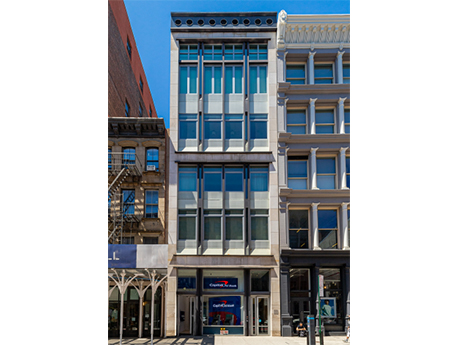By Brent Glodowski, director, capital markets group, Avison Young
Conditions are looking up for retail real estate investment in New York City.
In one sense, “up” is the only way to go for a sector that has been bumping along the bottom of a trough. But with inflation tempering investors’ recent fascination with multifamily and industrial properties, retail also offers opportunities to acquire price-corrected assets when those other property types hover near cyclical peaks.

Brent Glodowski, Avison Young
Retail’s Head Start
New York’s retail real estate market was already suffering from changing consumer tendencies when COVID-19 arrived and thrust many retailers and their landlords into a full-blown crisis. Even when government-ordered shutdowns eased, remote work policies drained office buildings of the customer bases that had supported swaths of restaurants, shops and entertainment businesses. Home-bound workers became a redistributed daytime population, shifting demand for meal delivery and other retail to new areas.
Hundreds of small businesses went under, leaving vacant storefronts in their wake. Some retailers altered business plans to serve shifting customer bases that had developed new, pandemic-influenced consumption practices.
Landlords with vacancies to fill turned to traditional strategies, such as relocating tenants from out-of-the-way spaces to fill their most visible storefronts. Property owners also cast wider nets to fill rent rolls, turning former shops and showrooms into fulfillment operations and last-mile delivery hubs.
Along the way, lenders and landlords hashed out survival strategies. Harsh realities compelled some investors to cut their losses and sell retail properties at prices reflecting the market distress. Those transactions fed into comparable sales data that put downward pressure on prices on other properties.
By contrast, industrial and multifamily properties tended to prosper during the pandemic. Spending more time at home spurred residents to invest in comfort and conveniences, straining the metro area’s distribution networks to keep pace with demand for last-mile deliveries and fueling leasing at new residential projects.
While the pandemic created challenges for all property types, the hardships touching multifamily and industrial operations did little to slow the competitive bidding that drove pricing to perfection for many of those properties.
Now, with inflation at a 40-year high, financing costs are beginning to rise. Industrial and multifamily owners are feeling pressure to lower asking prices to keep their properties within reach for leveraged buyers.
The industrial and multifamily markets appear to be at the top of a hill, looking ahead to what could be a protracted period of downward adjustments in prices and property values.
In that context, retail real estate offers an attractive alternative. New York City’s retail sector is emerging from a trial by fire that transformed its surviving inventory into leaner, more efficient and more appropriately priced assets. The market presents numerous opportunities to acquire retail properties at corrected pricing, giving buyers room to earn a healthy return.
New Opportunities
Today, landlords are driving occupancy and returns through creative strategies designed to play upon retail strengths in the pandemic and post-pandemic economy. Here are a few of the trends they are tapping into.
Retailers make flight to quality. One merchant’s loss is often another retailer’s gain in real estate. E-commerce adoption was steadily taking a greater and greater share of retail sales for at least a decade, but online transactions made an exceptional leap forward in 2020. That’s when consumers took refuge in their homes against COVID-19, and many learned for the first time how to order meals, household goods and groceries online for pickup or delivery. They also grew used to obtaining many services online that they once obtained in person, such as banking.
The loss of business was too much for many operators. Yet store closures created opportunities for surviving businesses to access previously inaccessible spaces. Former bank branch offices, for example, are becoming a favorite with providers of medical services, such as urgent care. Banks have typically occupied highly visible and accessible ground-floor locations, such as hard corners at busy intersections, that work equally well for businesses that still provide their services primarily in person.
New categories of retail fill low-visibility spaces. Many of the businesses that have grown stronger under pandemic conditions have heavily or exclusively shifted to delivery rather than on-premise shopping or dining. Ghost kitchens, for example, may have no need for street-front visibility to attract and serve customers.
Just last year, Avison Young helped a client sell a parking garage that was converted into a kitchen commissary, where a number of established restaurants lease space to prepare and deliver meals.
Similarly, some landlords have leased former retail spaces as small-scale fulfillment centers that put operators close to the densely populated neighborhoods they serve. These distribution-focused businesses are often eager to take well-located spaces and may be less concerned than traditional retailers with having showrooms, storefronts and exterior visibility to potential customers.
Reconfiguration boosts appeal. With fewer customers visiting stores in-person, many landlords and retailers have downsized the showrooms in their properties. This can reduce overall size to make leased space more affordable and can free square footage to process growing volumes of order processing for shipping and returns, making spaces more appealing to today’s retailers.
Traditional investors aren’t the only ones with a newfound appetite for New York City retail. A growing number of small businesses are buying small retail properties or condominiums to occupy. At a time when rising interest rates are increasing costs for many investors, these owner-occupiers can qualify for low-cost loans under U.S. Small Business Administration programs to finance an acquisition.
These emerging strategies are helping the city’s retail real estate market achieve healthy occupancy rates and clear attractive returns for investors. And as interest rates rise, transaction pricing and property values are sure to experience some pain in the coming months. That expectation suggests the investment pendulum is poised to swing toward retail real estate.
— This article originally appeared in the June/July 2022 issue of Northeast Real Estate Business magazine.


